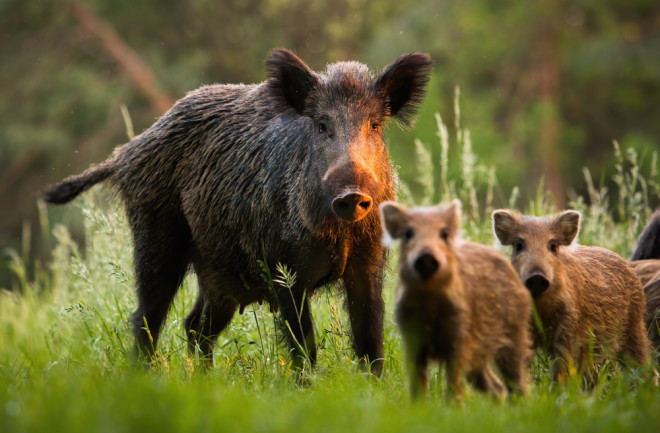When you think of great survivors in the animal kingdom, your mind might not immediately go to the humble pig, but maybe it should. In the wild, pigs are extremely durable — they can thrive in almost any environment — and they’re well-known for being able and willing to eat just about anything.
While those two traits signal that wild pigs are highly adaptable creatures, they also make them a nuisance; in the U.S., feral hogs are now considered a highly destructive invasive species. But in Europe, especially in Bavaria, Germany, the meat of the hairy, tusked wild boar (Sus scrofa) is one of the most popular forms of game meat, making those pigs particularly prized prey among hunters in that part of the world.
Yet, for many years, scientists have known that these hogs have a unique affliction that is both a mystery and something of a menace. In short, a significant portion of the German wild boar population — more than 1 in 3, in certain locales, according to some testing — is radioactive.
German hunters who kill a wild boar are supposed to submit it to authorities for testing. Often, the meat of the pig is deemed too radioactive for human consumption and must be destroyed. The situation has led many hunters to stop harvesting wild boars altogether, giving rise to a new problem: the proliferation of these feral pigs.
But what makes these wild German boars so radioactive in the first place? For a while, scientists thought they knew, but the real reasons behind these “hot” hogs were something far more unexpected.
What Is the Wild Boar Paradox?
Since about 1986, researchers believed that they understood why pigs lit up the Geiger counter on radioactivity. They tended to register for high levels of a certain radioactive isotope known as cesium-137 — an isotope associated with nuclear reactors, among other things. And in 1986, one particular nuclear reactor emitted a whole bunch of cesium-137 into the atmosphere.
The Cause of Radioactive Isotopes in Wild Boars
That reactor? Chernobyl, the Ukrainian nuclear power plant that suffered an explosion and partial meltdown of its core, resulting in the worst nuclear disaster in history. Thanks to prevailing winds and weather patterns, cesium-137 fallout drifted several hundred miles across Europe.
Unsafe Levels of Radiation in European Animals
For many years thereafter, plenty of wild European animals besides pigs were deemed to be contaminated by that fallout, especially in the vicinity of Chernobyl. You wouldn’t have wanted to eat any of those creatures unless you were prepared to absorb unsafe levels of radiation and accept the health risks that might entail. Over time, though, as the cesium-137 from Chernobyl dispersed, the radiation levels of most animals within the massive fallout zone dropped to less-than-dangerous levels.
Lasting Effects of Radiation in Boars
Curiously, that didn’t happen with wild boars. The stomach and tissue samples of the boars that researchers tested still continued to exhibit unsafe levels of cesium isotopes. Why were these pigs still so radioactive when other animals in the same habitats were not? It was a conundrum, one so profound and mystifying that it came to be known in some scientific circles as the “wild boar paradox.”
Read More: Have Chernobyl Mutations Rewired Evolution?
Why Are Germany’s Wild Boars Still Radioactive?
Eventually, scientists thought they had it figured out. Researchers were able to conclusively link wild boars’ excessive radioactivity to their diet. It turns out that feral pigs go hog-wild for so-called deer truffles (Elaphomyces granulatus), which grow a few inches below ground level and tend to absorb high levels of radioactive cesium. Boars rely on the truffles as a major food source at certain times of the year.
How Wild Boar Diet Contributes to Radioactivity
But even though wild boars like to root out those radioactive truffles, more than 30 years after the Chernobyl disaster, researchers still should have seen some declines in the wild pigs’ contamination levels. Why didn’t they?
Recently, that answer was determined: the cesium-137 that the truffles absorbed wasn’t simply coming from Chernobyl, but from a much older source.
Read More: Military Action In Radioactive Chernobyl Could Be Dangerous For People And The Environment
Nuclear Weapon Testing and Cesium-137 Contamination
Researchers in Germany and Austria concluded that a sizable portion of the cesium contamination was the result of years of 20th-century nuclear weapons tests, according to a study published in Environmental Science & Technology in 2023. These tests dated at least as far back as the 1960s, but the fallout from those decades-old weapons was still accounting for anywhere from 10 to nearly 70 percent of the radioactive contamination that scientists were finding in the wild boar population.
Environmental Challenges of Radioactive Isotopes
Although various international bans and agreements have curbed the testing of such weapons of mass destruction, it will be a while yet before cesium contamination ceases to be a problem for wild boars — and the people who like to eat them. Cesium penetrates the ground at an exceedingly slow rate, so slowly that researchers surmise the deer truffles have mostly absorbed just the “old” cesium from weapons testing.
Ongoing Concerns for Hunting Bavarian Wild Boar Meat
Meanwhile, the “new” cesium from Chernobyl is only recently reaching the underground depths where deer truffles grow. So, between the lingering residuals of nuclear tests and the Chernobyl disaster, Bavaria’s boars will continue to remain under watch, a potential vector for nuclear contamination for as long as pigs continue to root for those truffles.
Hunters who don’t wish to expose themselves or their customers to radioactive danger will need to keep submitting their wild hogs for testing for the foreseeable future. Make no mistake: It may still be several years before this “new” cesium abates enough that lovers of wild boar meat will be able to pig out — without fear of fallout.
Read More: Nuclear Warfare’s Past, Present and Future

